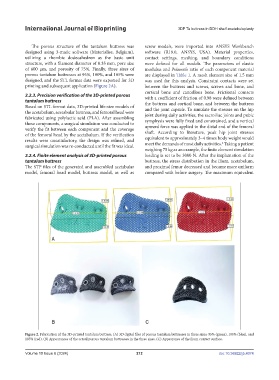Page 220 - IJB-10-6
P. 220
International Journal of Bioprinting 3DP Ta buttress in DDH shelf acetabuloplasty
The porous structure of the tantalum buttress was screw models, were imported into ANSYS Workbench
designed using 3-matic software (Materialise, Belgium), software (R19.0, ANSYS, USA). Material properties,
utilizing a rhombic dodecahedron as the basic unit contact settings, meshing, and boundary conditions
structure, with a filament diameter of 0.35 mm, pore size were defined for all models. The parameters of elastic
of 600 μm, and porosity of 75%. Finally, three sizes of modulus and Poisson’s ratio of each component material
porous tantalum buttresses at 95%, 100%, and 105% were are displayed in Table 1. A mesh element size of 1.5 mm
designed, and the STL format data were exported for 3D was used for this analysis. Constraint contacts were set
printing and subsequent application (Figure 2A). between the buttress and screws, screws and bone, and
cortical bone and cancellous bone. Frictional contacts
2.2.3. Precision verification of the 3D-printed porous with a coefficient of friction of 0.98 were defined between
tantalum buttress the buttress and cortical bone, and between the buttress
Based on STL format data, 3D-printed life-size models of and the joint capsule. To simulate the stresses on the hip
the acetabulum, acetabular buttress, and femoral head were joint during daily activities, the sacroiliac joints and pubic
fabricated using polylactic acid (PLA). After assembling symphysis were fully fixed and constrained, and a vertical
these components, a surgical simulation was conducted to upward force was applied to the distal end of the femoral
verify the fit between each component and the coverage shaft. According to literature, peak hip joint stresses
of the femoral head by the acetabulum. If the verification
results were unsatisfactory, the design was refined, and equivalent to approximately 3–4 times body weight would
4
surgical simulation was re-conducted until the fit was ideal. meet the demands of most daily activities. Taking a patient
weighing 75 kg as an example, the finite element simulation
2.2.4. Finite element analysis of 3D-printed porous loading is set to be 3000 N. After the implantation of the
tantalum buttress buttress, the stress distribution in the ilium, acetabulum,
The STP files of the generated and assembled acetabular and proximal femur decreased and became more uniform
model, femoral head model, buttress model, as well as compared with before surgery. The maximum equivalent
Figure 2. Fabrication of the 3D-printed tantalum buttress. (A) 3D digital files of porous tantalum buttresses in three sizes: 95% (green), 100% (blue), and
105% (red). (B) Appearances of the actual porous tantalum buttresses in the three sizes. (C) Appearance of the ilium contact surface.
Volume 10 Issue 6 (2024) 212 doi: 10.36922/ijb.4074

